
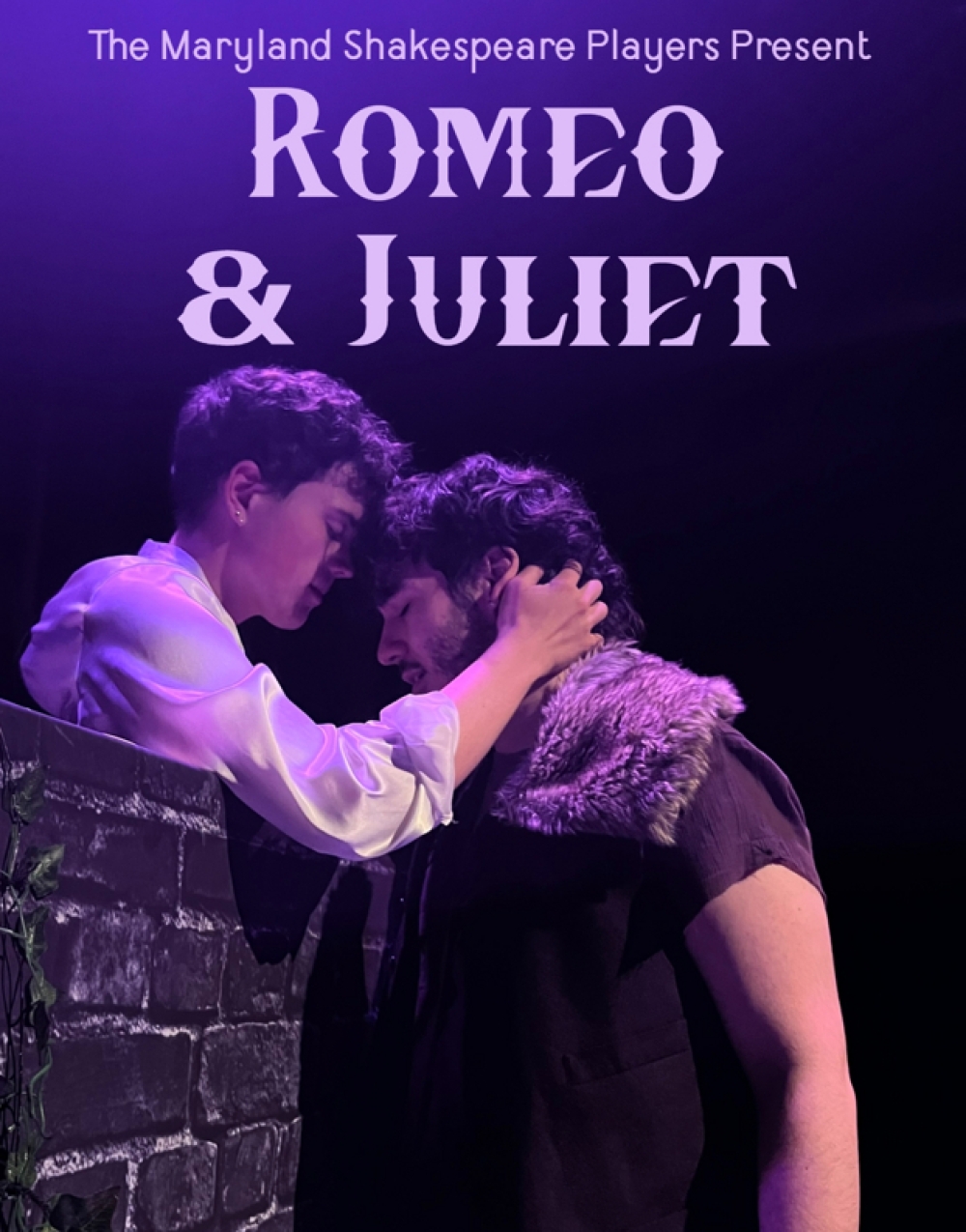
Romeo & Juliet |
||
|
|
||
|
|
|
|
|
|
||
|
Edith Corey Dylan Speiser |
Clare Reilly |
Elena Yeatts-Lonske |
Follow Us:
To stream this performance: https://youtube.com/@
Few of Shakespeare’s works are as big a part of the cultural lexicon as Romeo and Juliet, which makes it even more crucial that each production gives viewers a new perspective on a play that might otherwise seem stale. That being said, what’s more exciting than vampires and werewolves? Nothing, according to Stephanie Meyer, the inspiration behind this show. As I was digging through boxes of the club’s old props, inspiration struck when I serendipitously pulled out a copy of Twilight. To be honest, I pitched the idea of a vampire and werewolf Romeo and Juliet to Liam and Andy as a joke, but the enthusiasm with which they responded to it and their willingness to take on this project gave me the confidence to turn this idea into a reality. Plus, a little-known piece of MDSP lore is that every production pre-covid would sneak that fated copy of Twilight into the show. So, alongside fulfilling my selfish desire to costume a show full of mythical creatures, this production pays homage to the origins of our club as we round out its 15th year.
As we began world building, the stars aligned as we developed unwritten backstories for each character. In the first scene of the show, Sampson exclaims that “a dog of the house Montague” moves him, so naturally, the Montagues were established as the werewolves. The rest fell into place; Nurse, a human kept alive for blood and good company by the Capulets, Friar Lawrence, a
warlock whom Romeo seeks for assistance in holding onto his humanity. Lady Capulet is unhappy in her marriage with someone she is, literally, eternally bound to. Considering how well everything matched up, who’s to say that Shakespeare didn’t originally intend for these two houses to be divided by the ancient rivalry between vampires and werewolves?
Origin stories aside, I hope this production brings you joy in a time when the simple act of gender-blind casting could be perceived as a political act. When we cast our star-crossed lovers, it was immediately clear they had real chemistry. But I was worried that our choice to cast two men for Romeo and Juliet would lead audience members to a misconception that the central conflict of our production is homophobia. I want to emphasize that our decision to cast Juliet as a man, while maintaining the pronouns of the original text was a conscious choice of the directing team. The gender expectations that Juliet faces in the play are real and oppressive, even to this day, as Juliet’s family tries to strip her of her own autonomy. Our casting choice is not to take the spotlight off the problems that women face. Instead, it is to highlight that gender norms negatively impact everyone, and that we hamper the boundlessness of love when we enforce rigid expectations of what it should look like. In the end, I decided that, with a rivalry as strong as that between vampires and werewolves, or Montagues and Capulets, it didn’t matter. Besides, mythical creatures don’t subscribe to antiquated human bullshit like heteronormativity.
Although their love is doomed from the start (sorry for the spoiler!), it is always easy for me to root for Romeo and Juliet. There’s a reason that it is such a timeless story, and one that we can all stand to be reminded of; love is stronger than the things that divide us. It might be a bit silly for the Capulets to be vampires and the Montagues to be werewolves, but I hope the central themes of the show nonetheless inspire audience members to rethink any hatred towards others, and to leave a little kinder towards those they do not understand. Please enjoy this show, we are so proud of it.
- Zoe Gallagher, Artistic Director
Cast
Creative Team
Andy Hindenach (they/them)
Liam O'Donoghue (he/him)
Zoe Gallagher (she/her)
Kiefer Cure (he/him)
Adam Hawley (he/him)
Ryan Lindner (she/her)
Alex Bryan-Taff (he/him)
Betsy Barrett (any)
Max Abramovitz (he/him)
Claire Nelson (she/her)
Lucas Armyn (he/him)
Victor Ley (he/him)
Chiso Obichere (she/her)
Maria Nikolaitchik (she/her)
Thomas Prestwich (he/him)
Matthew Simmons (he/him)
Meet the Company
Nathan Cavaliere (he/him)
Mia Cohen (she/her)
Edith Corey (she/her)
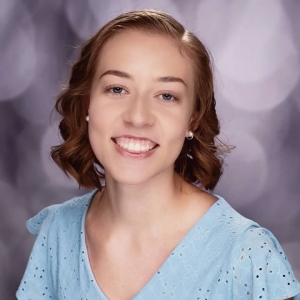 Edith is a Freshman Psychology major. This is her first production with the Maryland Shakespeare Players, and she is so happy to be a part of this show. She would like to thank her friends for convincing her to audition and everyone she has met along the way for reminding her why she loves theatre. She hopes you enjoy the show!
Edith is a Freshman Psychology major. This is her first production with the Maryland Shakespeare Players, and she is so happy to be a part of this show. She would like to thank her friends for convincing her to audition and everyone she has met along the way for reminding her why she loves theatre. She hopes you enjoy the show!
Cameron Denny (he/him)
Logan Garvin (he/him)
Rin Gourianova (any)
Rina Haimson (she/her)
Mikey Howerton (he/him)
Lilia Karapetyan (she/her)
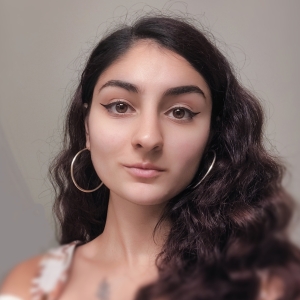 A Senior Criminology and French double major, she has played Beatrice (Much Ado About Nothing), Goneril (King Lear), and Duke Orsino (Twelfth Night). This, however, will be her final farewell to MDSP, so you can be sure it will be very dramatic... and bloody! Please enjoy her portrayal of Boys Being Boys in this show titled "It's All Fun and Games until Someone Loses an Eye, or Dies." Speaking seriously, she would like to thank the entire club for making her years on campus so warm and memorable.
A Senior Criminology and French double major, she has played Beatrice (Much Ado About Nothing), Goneril (King Lear), and Duke Orsino (Twelfth Night). This, however, will be her final farewell to MDSP, so you can be sure it will be very dramatic... and bloody! Please enjoy her portrayal of Boys Being Boys in this show titled "It's All Fun and Games until Someone Loses an Eye, or Dies." Speaking seriously, she would like to thank the entire club for making her years on campus so warm and memorable.
Grace Levine (she/they)
Liam McCue (he/him)
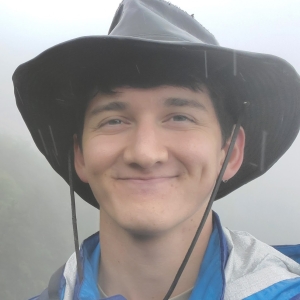 Is a senior aerospace engineering major. This is his first and last production with MDSP. He has had a blast reprising his role as Montague from high school. He would like to thank his family for their support and he hopes you enjoy the show!
Is a senior aerospace engineering major. This is his first and last production with MDSP. He has had a blast reprising his role as Montague from high school. He would like to thank his family for their support and he hopes you enjoy the show!
Aidan Owens (he/him)
Jacob Pelzman-Kern (he/him)
Ema Rajala (they/them)
Clare Reilly (she/her)
Dylan Speiser (he/him)
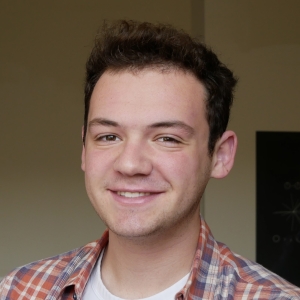 is super excited for his second-ish MDSP production. Dylan is a Sophomore Computer Engineering major who is proud to call the theater his home, whether playing onstage or dangling lights from the catwalks offstage. He’d like to thank his family for enabling his dramaticism, and the cast and crew of this awesome show for becoming his friends along the way.
is super excited for his second-ish MDSP production. Dylan is a Sophomore Computer Engineering major who is proud to call the theater his home, whether playing onstage or dangling lights from the catwalks offstage. He’d like to thank his family for enabling his dramaticism, and the cast and crew of this awesome show for becoming his friends along the way.
Nicky Sremac-Saari (he/him)
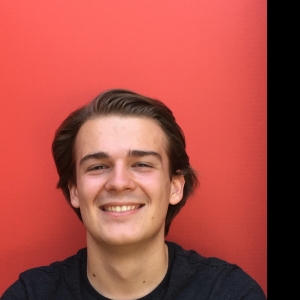 Nicky Sremac-Saari is a series of romance fantasy films based on the book series Twilight by Stephenie Meyer. He has grossed over $3.4 billion worldwide. He has been in MDSP’s productions of King Lear, Twelfth Night, and is now very excited to add Romeo and Juliet to the list.
Nicky Sremac-Saari is a series of romance fantasy films based on the book series Twilight by Stephenie Meyer. He has grossed over $3.4 billion worldwide. He has been in MDSP’s productions of King Lear, Twelfth Night, and is now very excited to add Romeo and Juliet to the list.
Elena Yeatts-Lonske (she/they)
Raphaella Tenembaum (she/her)
Andy Hindenach (they/them)
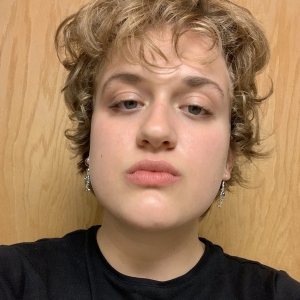 is a senior Psychology major. They are delighted to welcome you to their final production with the Maryland Shakespeare Players, with whom they have found a home for the last four years. They want to thank Liam, Ryan, Kiefer, Zoe, Claire, Betsy, and Adam; Lilia, Mikey, Jacob, and Elena; Rachel and Rachel; Paul, Jack, and Percy. And they want to thank you, reader– they hope you enjoy the show.
is a senior Psychology major. They are delighted to welcome you to their final production with the Maryland Shakespeare Players, with whom they have found a home for the last four years. They want to thank Liam, Ryan, Kiefer, Zoe, Claire, Betsy, and Adam; Lilia, Mikey, Jacob, and Elena; Rachel and Rachel; Paul, Jack, and Percy. And they want to thank you, reader– they hope you enjoy the show.
Liam O'Donoghue (he/him)
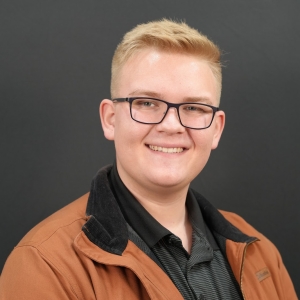 is a junior Mechanical Engineer major, minoring in Project Management. His MDSP credits include MDSP's Virtual 15-Minute Tragedies (Tybalt, Paris, Edmund, Julius Caesar), Much Ado About Nothing (Leonato), King Lear (Albany), and Twelfth Night (Asst. Director/Fight Captain). He has also appeared in TDPS's Book Club Play (u/s Male Pundit). Liam would like to thank Zoe, Andy, Kiefer, and the entire cast, crew, and production team of Romeo and Juliet for helping make this dream a reality.
is a junior Mechanical Engineer major, minoring in Project Management. His MDSP credits include MDSP's Virtual 15-Minute Tragedies (Tybalt, Paris, Edmund, Julius Caesar), Much Ado About Nothing (Leonato), King Lear (Albany), and Twelfth Night (Asst. Director/Fight Captain). He has also appeared in TDPS's Book Club Play (u/s Male Pundit). Liam would like to thank Zoe, Andy, Kiefer, and the entire cast, crew, and production team of Romeo and Juliet for helping make this dream a reality.
Zoe Gallagher (she/her)
Kiefer Cure (he/him)
Adam Hawley (he/him)
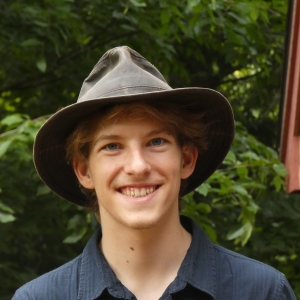 Sophomore theatre major. Creative and Performing Arts Scholar. Recent Works: The Book Club Play (UMD, ASM), As You Like It (UMD, ASM) Matilda, Guys and Dolls (Imagination Stage, Props Designer), Beauty and the Beast (Olney Theatre Center, Props Artisan).
Sophomore theatre major. Creative and Performing Arts Scholar. Recent Works: The Book Club Play (UMD, ASM), As You Like It (UMD, ASM) Matilda, Guys and Dolls (Imagination Stage, Props Designer), Beauty and the Beast (Olney Theatre Center, Props Artisan).
Ryan Lindner (she/her)
Alex Bryan-Taff (he/him)
 Alex is very grateful for the opportunity to have worked on this wonderful show, with this amazing cast and crew. He deeply regrets not being able to engage in that opportunity, having been replaced by a reptoid clone 5 months prior. He would also like to request that someone mount a rescue operation, please, for the love of God, come save me, please.
Alex is very grateful for the opportunity to have worked on this wonderful show, with this amazing cast and crew. He deeply regrets not being able to engage in that opportunity, having been replaced by a reptoid clone 5 months prior. He would also like to request that someone mount a rescue operation, please, for the love of God, come save me, please.
Betsy Barrett (any)
Max Abramovitz (he/him)
Claire Nelson (she/her)
Lucas Armyn (he/him)
Victor Ley (he/him)
Chiso Obichere (she/her)
Maria Nikolaitchik (she/her)
Thomas Prestwich (he/him)
Matthew Simmons (he/him)
Photos
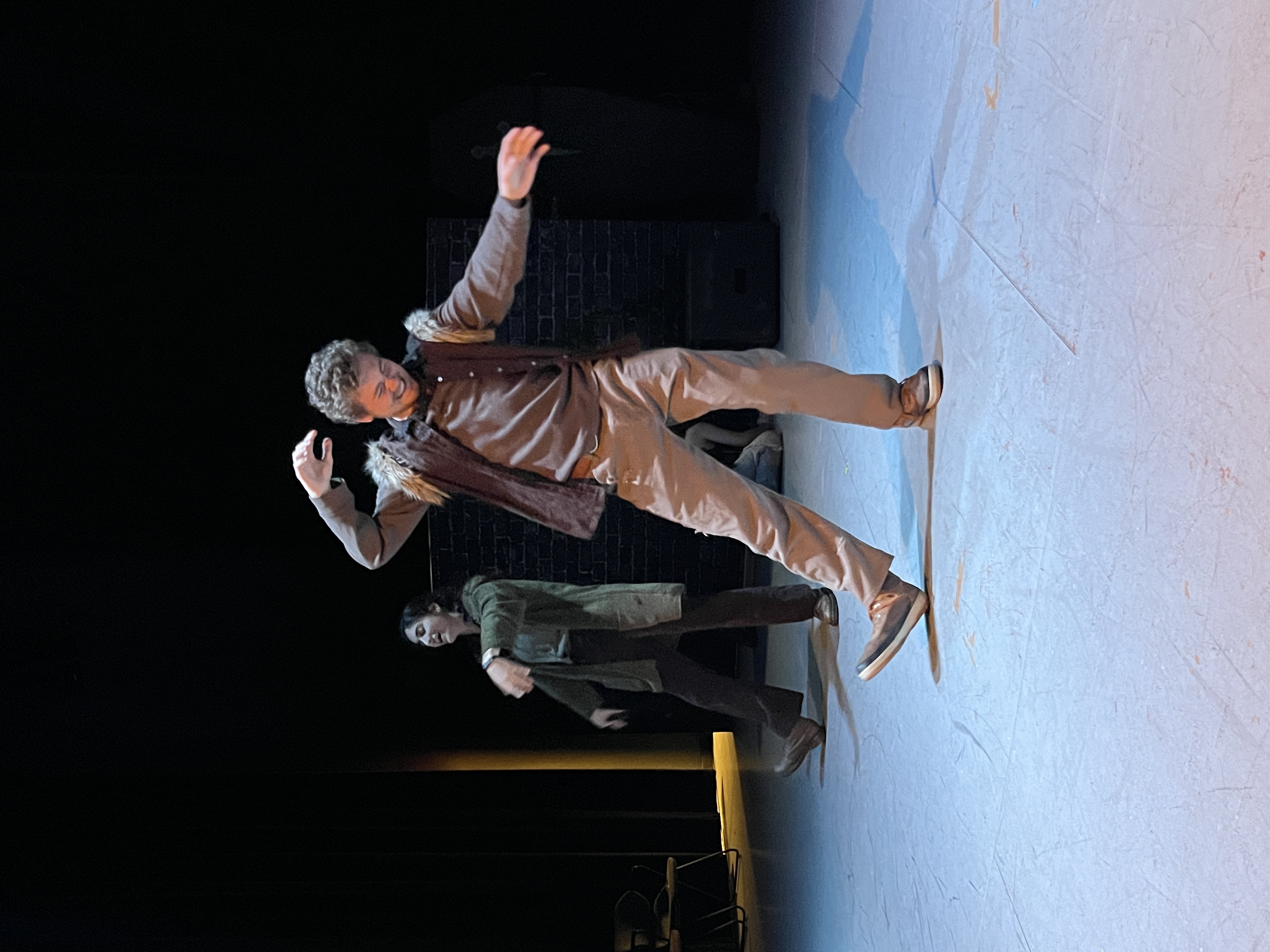
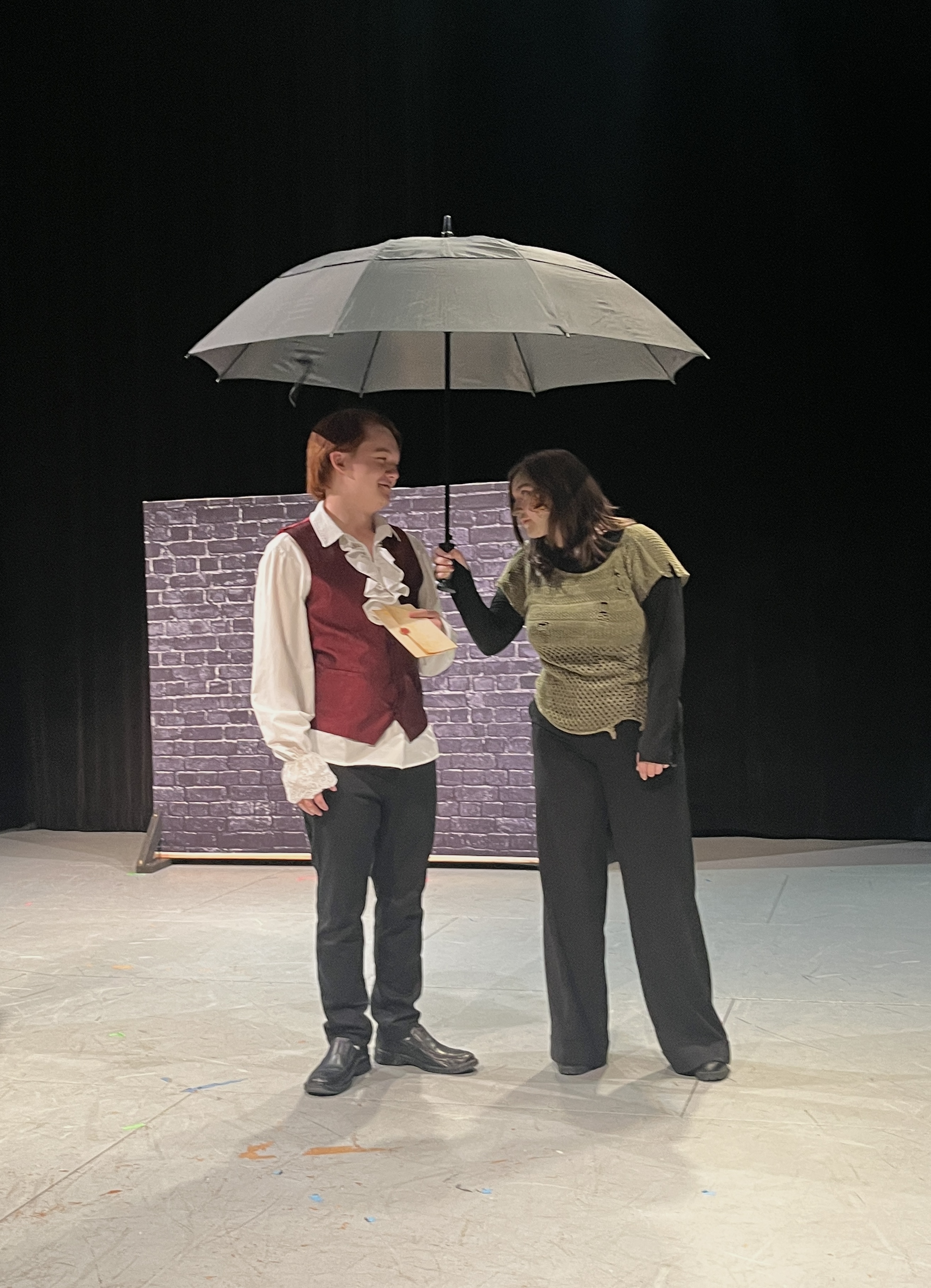
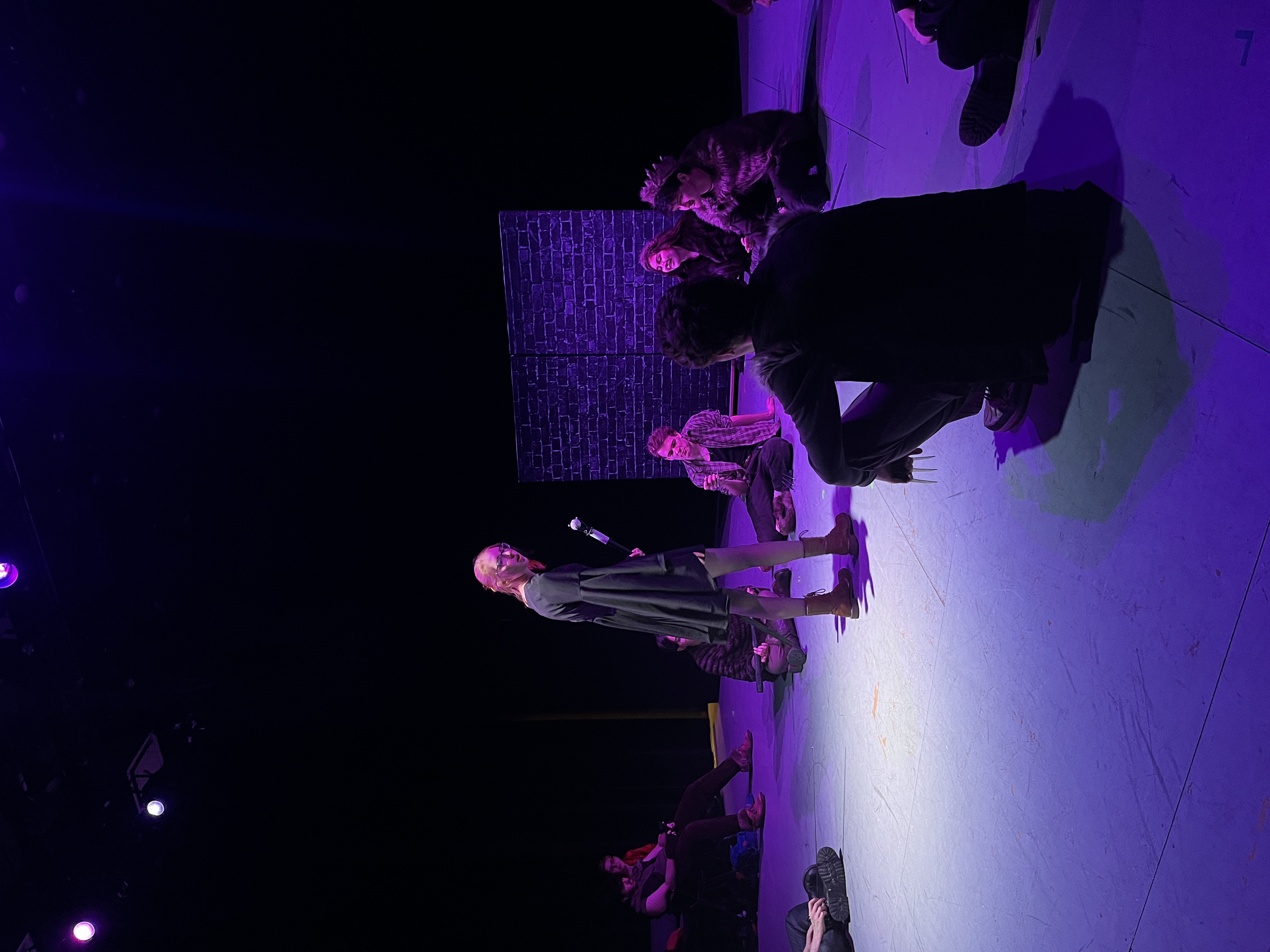
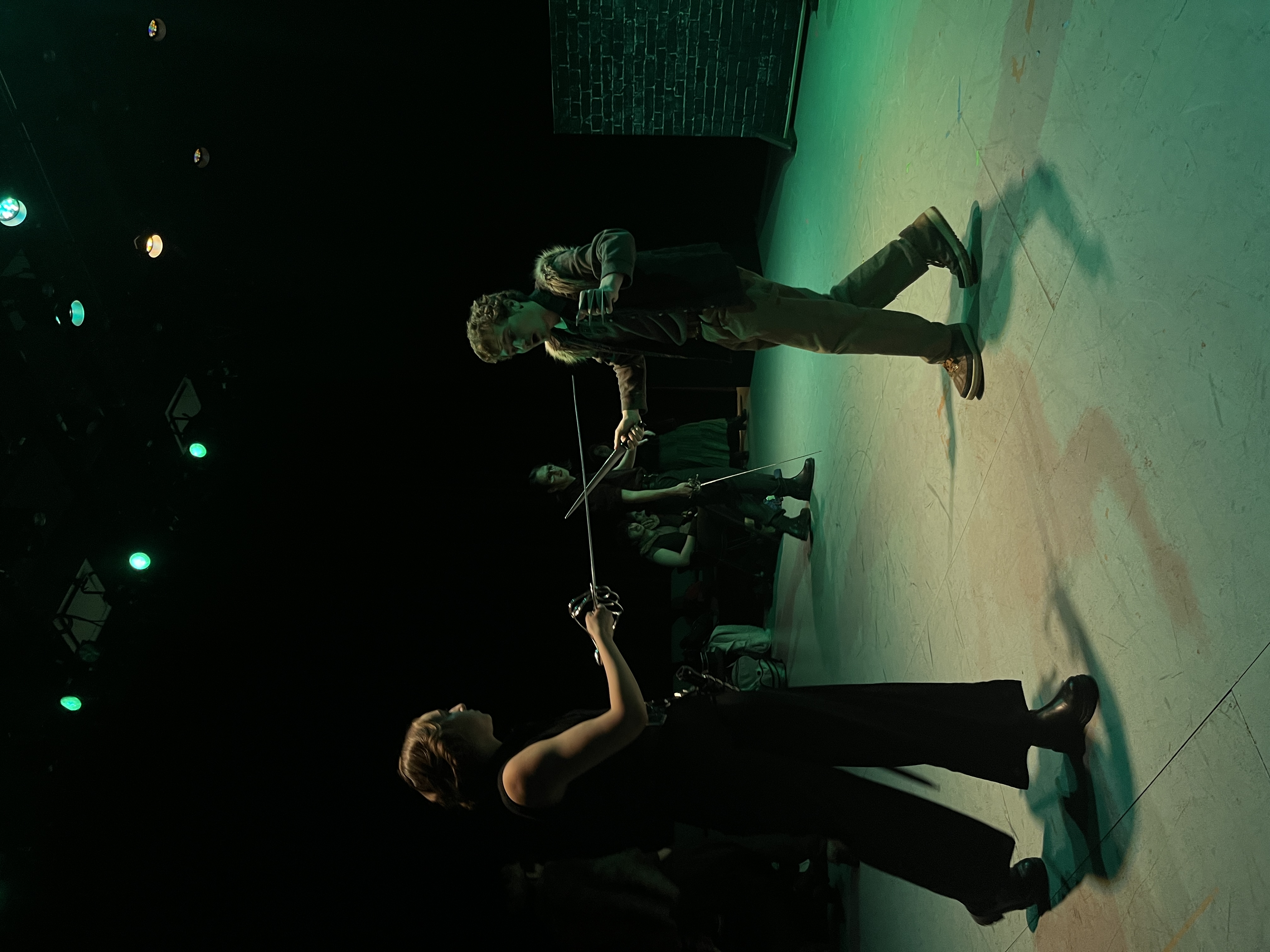
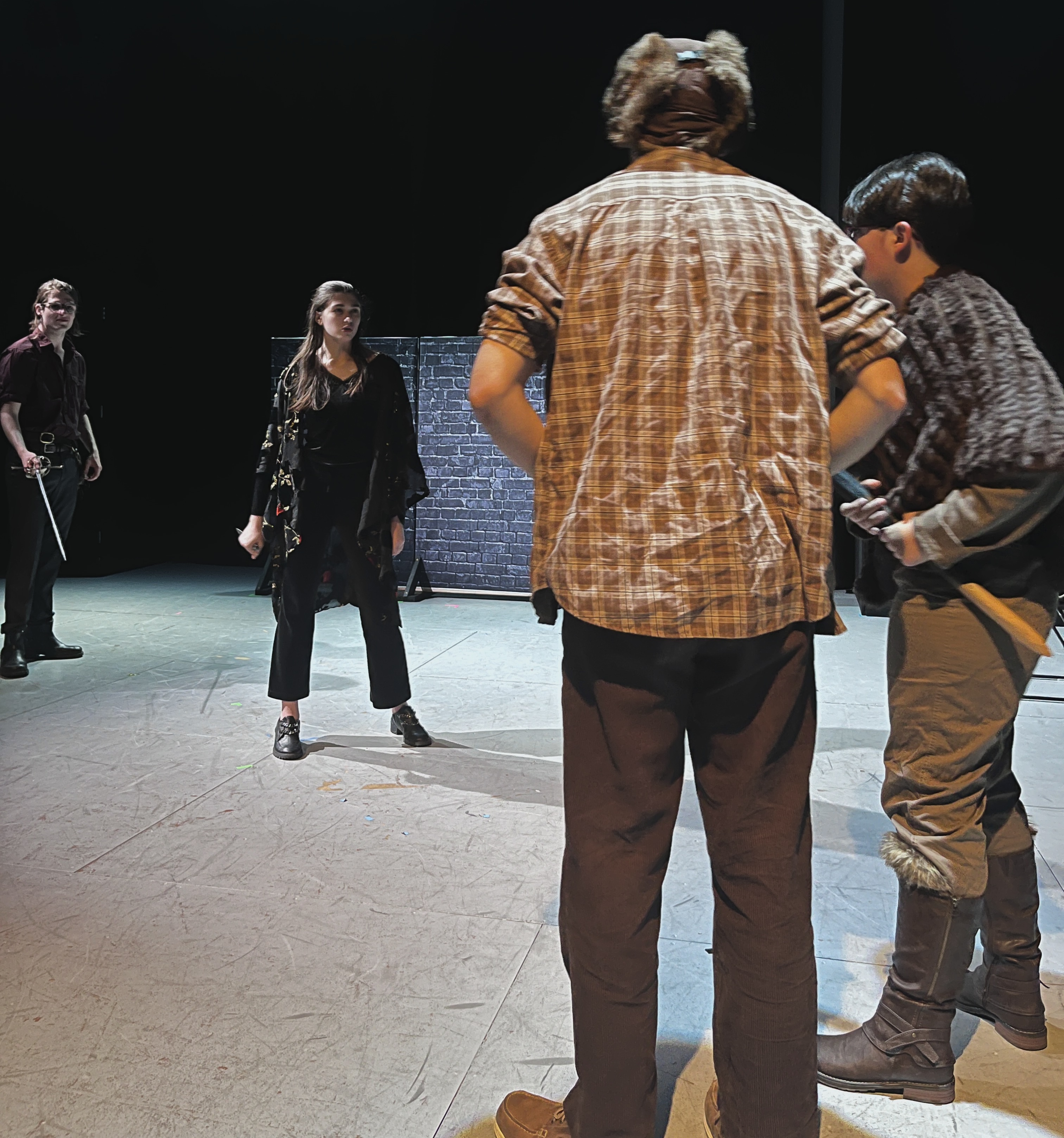
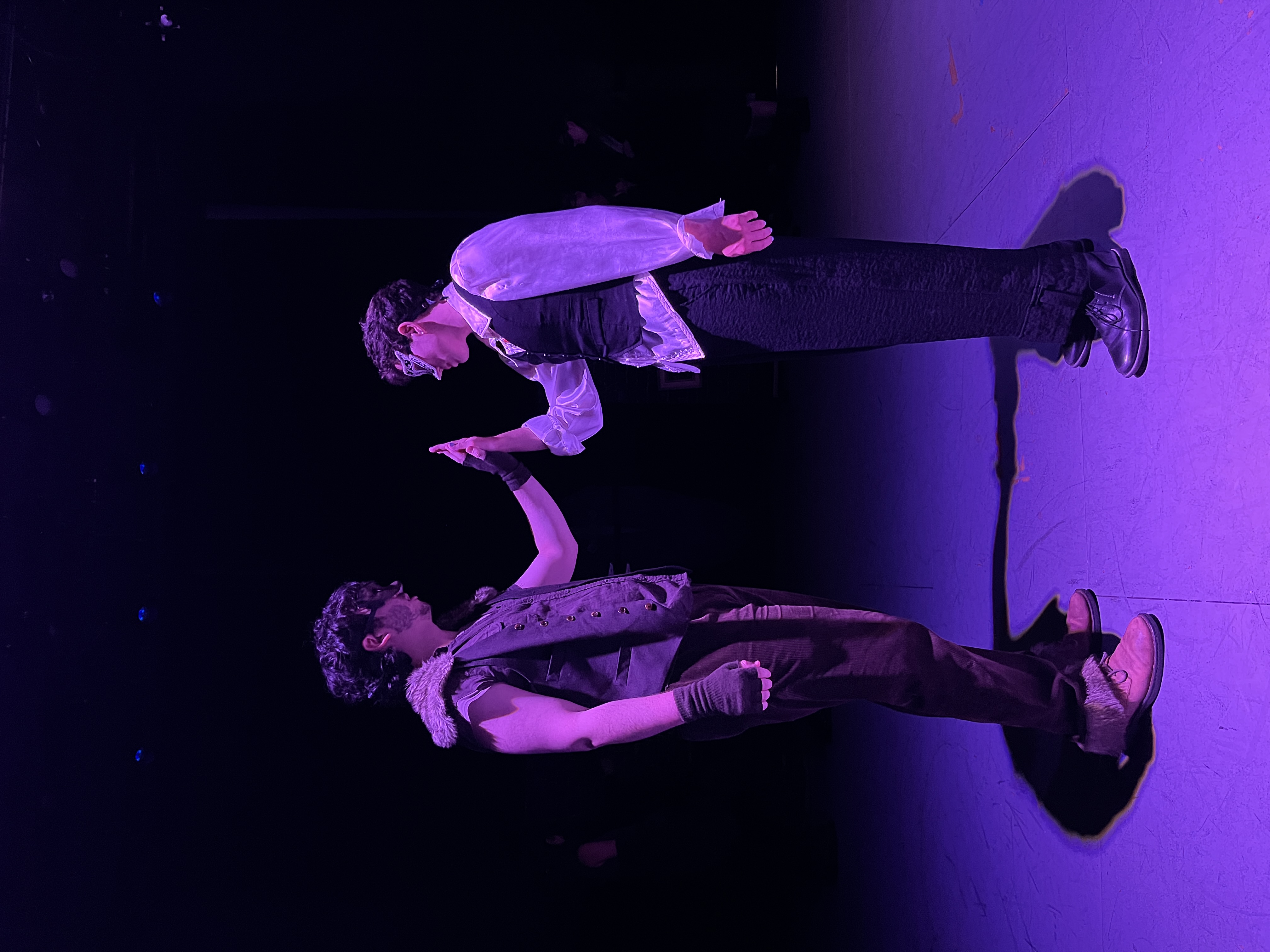
Special Thanks:
Beth Ribar
Jen Osborne
Sam Crawford
Andrew Cissna
Dr. Karen Nelson
Myers Brinn Institute
Clarice Smith Performing Arts Center Staff
Extra special thanks to Matt Reader for constructing our most crucial set piece, the coffin, despite his son graduating last semester. We are so grateful for your kindness and contribution to this production. And an additional thank you to Betsy Barrett, who dedicated more than several hours of their life to bring the coffin to life - or should we say death - through painting and upholstering.
Another special thanks to Alana Isaac for putting together this program and playing an instrumental role in our tech process!
